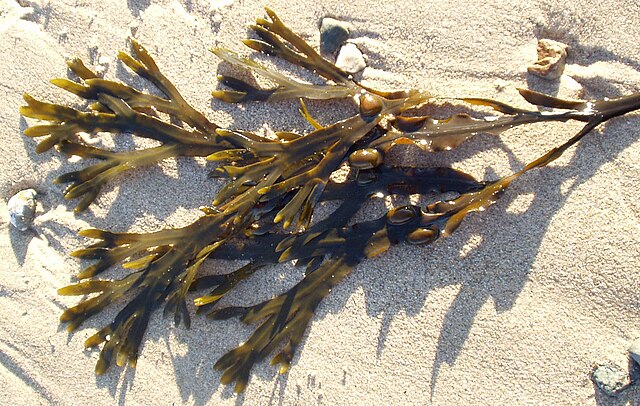Loading AI tools
The Lulworthiaceae are a family of marine fungi in the Ascomycota, class Sordariomycetes.[1] Species in the family have a widespread distribution in both temperate and tropical oceans, and are typically found growing on submerged wood or on seaweed.[2] In 2000, Molecular analysis of several species of Lulworthia and Lindra led to the reassignment of their parent genera to the new order Lulworthiales in addition to the new family Lulworthiaceae.[3] In 2020, a large fungi study added more genera to the family.[4]
| Lulworthiaceae | |
|---|---|
| Scientific classification | |
| Kingdom: | |
| Division: | |
| Class: | |
| Order: | |
| Family: | Lulworthiaceae Kohlm. |
| Type genus | |
| Lulworthia G.K. Sutherl. | |
The type genus Lulworthia was originally described in 1916 by George Kenneth Sutherland to contain the species Lulworthia fucicola, a fungus found on the seaweed commonly known as the bladder wrack at Lulworth on the coast of Dorset, UK.[5] The fungus has since been collected several times from submerged wood, but never again from the original algal host; it was subsequently reported that specimens found on wood were morphologically different from those originally described growing on algae.[6] Since the original specimens had deteriorated beyond use, a holotype was designated, using submerged-wood specimens found in Chile in 1984.[7]
The genus Rostrupiella was created in 2007 to contain the species Rostrupiella danica, a Lulworthia-like species collected on driftwood found along the Danish coast and from the northwestern coast of the US.[8]

As accepted by Wijayawardene et al. 2020 (with amount of species per genus);[4]
- Cumulospora I. Schmidt (2)
- Halazoon Abdel-Aziz, Abdel-Wahab & Nagah. (2)
- Haloguignardia A. Cribb & J. Cribb (1)
- Hydea K.L. Pang & E.B.G Jones (1)
- Kohlmeyeriella E.B.G. Jones, R.G. Johnson & S.T. Moss (2)
- Lindra I. Wilson (5)
- Lulwoana Kohlm., Volkm.-Kohlm., J. Campb., Spatafora & Gräfenhan (1)
- Lulwoidea Kohlm., Volkm.-Kohlm., J. Campb., Spatafora & Gräfenhan (1)
- Lulworthia G.K. Sutherl (32)
- Matsusporium E.B.G. Jones & K.L. Pang (1)
- Moleospora Abdel-Wahab, Abdel-Aziz & Nagah (1)
- Moromyces Abdel-Wahab, K.L. Pang, Nagah., Abdel-Aziz & E.B.G. Jones (1)
- Orbimyces Linder (1)
- Paralulworthia A. Poli, E. Bovio, L. Ranieri, G.C. Varese & V. Prigione (3)
- Rostrupiella Jørg Koch, K.L. Pang & E.B.G. Jones. (1)
- Sammeyersia S.Y. Guo, E.B.G. Jones & K.L. Pang (1)
The ascomata, roughly spherical to cylindrical in shape, may be either embedded in or on the material to which the fruit body is attached. Atop the ascomata is a small rounded process with an opening (an ostiole) through which ascospores may be released. The brown- to black-colored ascomata can be either leathery (coriaceous) or dark-colored and readily broken (carbonaceous). The internal structure of the ascomata, the centrum, is at first filled with a transparent pseudoparenchyma (a type of tissue made of hyphae that are twisted and matted together) dissolves upon reaching maturity. The Lulworthiaceae have ascospores that are both filamentous, and transparent.[3]
Wikiwand in your browser!
Seamless Wikipedia browsing. On steroids.
Every time you click a link to Wikipedia, Wiktionary or Wikiquote in your browser's search results, it will show the modern Wikiwand interface.
Wikiwand extension is a five stars, simple, with minimum permission required to keep your browsing private, safe and transparent.